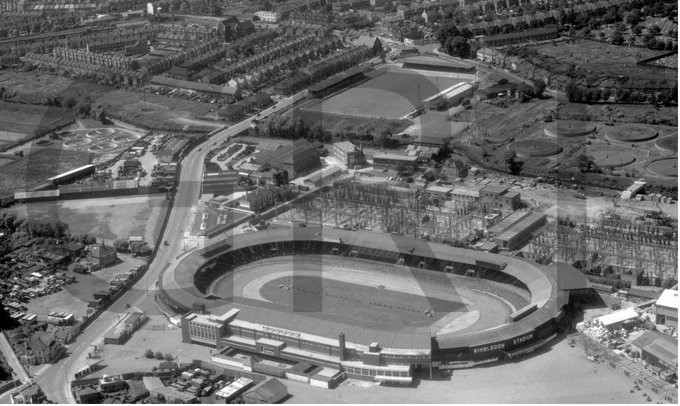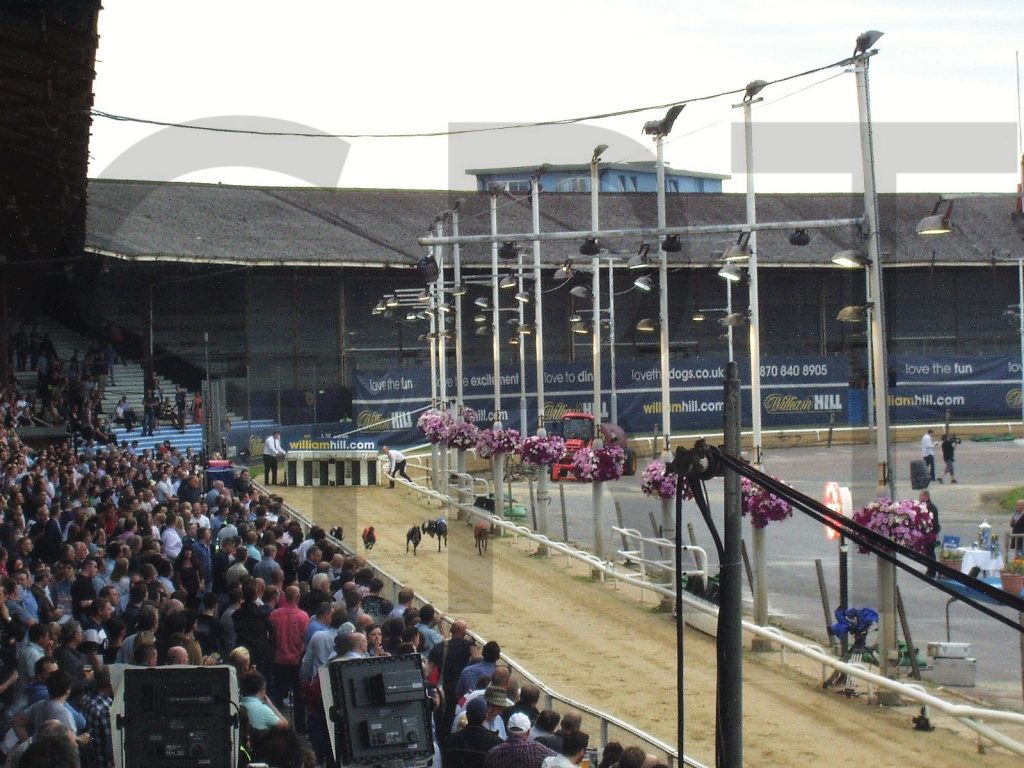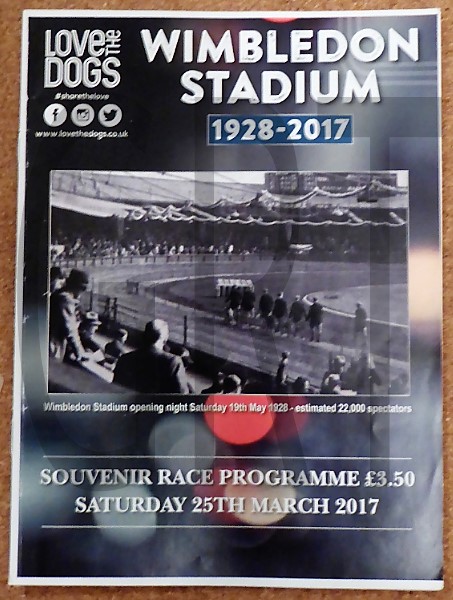Plough Lane, Wimbledon, Surrey, Greater London.
POSTCODE———————————-SW17 0BL
LOCATED————————————Amidst an Industrial Estae just off Plough Lane, about seven miles south of the City of London and about half mile north of Hayden’s Road Railway Statiion.
ORIGINAL SITE—————————–Marshland that was drained to makw way for a football ground called The Coppermill Ground the home of Wimbledon Borough Football Club.
DATE CONSTRUCTED——————–As a football bround during the post years of the First World War.
DATE VENUE OPENED——————-About 1920 for football.
Meaning other sports may have taken place prior to the arrival of Greyhound Racing.
FIRST MEETING—————————–May 19th 1928.
Greyhound Racing only.
LICENSED OR INDEPENDENT———-NGRC.
All venues covered would have to be licensed with the government, licensed suggested in this section would refer to tracks operating under NGRC Rules.
INSIDE OR OUTSIDE HARE TYPE——Outside Swaffham.
Please note that the Electric Hare suggested is only a guidance, and would have been in operation for a certain amount of time at this venue. Although it is not necessarily guaranteed that it was operational all the time, as other types of lure may have been used and updated as time progressed.
DISTANCES———————————–273, 480, 687 and 894 metres.
Please note that most racing venues distances had become varied throughout the years, the ones given above were at once point set and offers only a guidance to the track size.
CIRCUMFERENCE—————————414 metres.
Please note that alterations at most racing venues throughout its existence would see that the circumference of the track would vary, the one shown above offers only a guidance to the track size.
BIG RACE NAMES—————————The English Greyhound Derby, The Laurels The Oaks and many more.
STADIUM SHARED WITH——————Stock Car Racing and Speedway.
LAST MEETING——————————-March 25th 2017.
Greyhound Racing only.
STADIUM CLOSURE DATE—————-March 2017.
Meaning other sports may have taken place after Greyhound Racing had ceased.
STADIUM DEMOLITION——————-2018
BUILT ON SITE——————————-Demolition complete ready for construction of a new football stadium.
In some cases, structure’s that originally covered the venue after the stadium had been demolished, may have been themselves demolished too, so the one described is more likely to be the one which now presently covers the site.
EVIDENCE LEFT TODAY——————-At present a demolished state.
FURTHER COMMENTS——————–None








































The Wimbledon Greyhound Stadium was situated just off Plough Lane, roughly seven miles south east of London city centre, and half a mile north of Haydens Road Railway Station. The venue lay amidst a busy industrial estate, having developed on marshland during the years leading up to the First World War, and had initially been a football pitch for the newly formed Wimbledon Borough Football Club.
Originally known as the Coppermill Ground, the site began to develop into an enclosed football ground during the years following the First World War, with earth banked terracing surrounding the pitch, along with a small seated covered stand situated down one side. But the 1920’s brought with it the demise of the football club, the main reason was the lack of interest through the turnstiles, therefore lack of funds, forcing the club to fold, which in turn left the ground unoccupied.
It was during 1927 that the newly established Greyhound Racing Association, purchased the venue, and transformed its rectangular shape into the more oval shape as it became. Wimbledon had become the fifth licensed Greyhound Racing venue to open in the Borough of London, after venues at White City, Harringay, Wembley and Clapton, who were already in operation. The new venue was now known as The Sports Stadium, and opened with its inaugural meeting on the 19th of May 1928, when a greyhound called World of Roses won the first event. But like many new stadiums constructed around this period, The Wimbledon Stadium was designed to host other sports as well, such as the up-and-coming attraction of Dirt Track Speedway, whose opening meeting was also staged during May 1928.
As the Second World War loomed, regulations were being enforced regarding crowd gatherings at public venues, which would see a closure of the stadium on the 30th of August 1939. After regulations had been relaxed a month later, racing resumed, although only one afternoon meeting per week was permitted. But the stadium did not get away lightly during hostilities, as during an air raid on the 23rd of February 1944, the venue suffered a direct hit from a number of incendiary bombs, which in turn virtually destroyed the main stand. But in order to continue racing, they moved the starting traps, the winning lane and the judges box to the opposite side of the track. It may have been business as usual at Wimbledon thereafter, but it wasn’t until 1954 that a new grandstand replaced its predecessor, costing over £300,000 to construct, the time lapsed due to the War Damage Compensation scheme taking time.
Speedway returned in 1946 with Wimbledon Dons continuing to run side by side with Greyhound Racing right up until 1991. Speedway returned once again in 2002, but this time the partnership lasted for just three seasons only, after a dispute with the GRA regarding the lease and overpriced rent, unfortunately these issues contributed to The Dons folding in 2005. But it wasn’t the end of motor sports at Wimbledon, as Stock Car Racing made its first appearance during 2005.
Wimbledon continued to stage events under NGRC rules, promoting six dog racing over distances of 273, 480, 687 and 894 metres, with the hounds chasing an outside Swaffham type hare. At the time, London Borough’s only greyhound stadium had a crowd capacity of around 6,000, with its main feature being a glass fronted air condition restaurant which accommodated 250 diners. In modern times, it had hosted classic events such as The Grand National, The Puppy Derby, The St Leger and the big one of course “The Greyhound Derby”, incidentally held there since London White City closed in 1984. Other classics that were once staged at Wimbledon, was The Laurels and The Oaks, both of which were contested at Manchester’s Belle Vue Stadium.
Since the beginning of the second decade of the new millennium, Wimbledon’s future began to look bleak, as the site had been in deep discussions for a new football stadium to take its place. With the vast amount of money being paid for land in South London, and with AFC Wimbledon looking for a return to the borough, it may not have come as a surprise that a deal had been done. With the GRA having accepted a vast figure from a Sporting Consortium for the stadium and its surrounds, closure of the stadium now lay on the horizon.
Sadly, Wimbledon Greyhound Stadium staged its final meeting on the 25th of March 2017, when a 10-1 shot called Glitzy King won the very last race. At the time of writing the demolition teams have arrived and the foundations of London’s last Greyhound Racing venue will disappear beneath a different type of sporting venture.
Memorabilia for this track is required for this page, if you can help please contact me.

Recent Comments